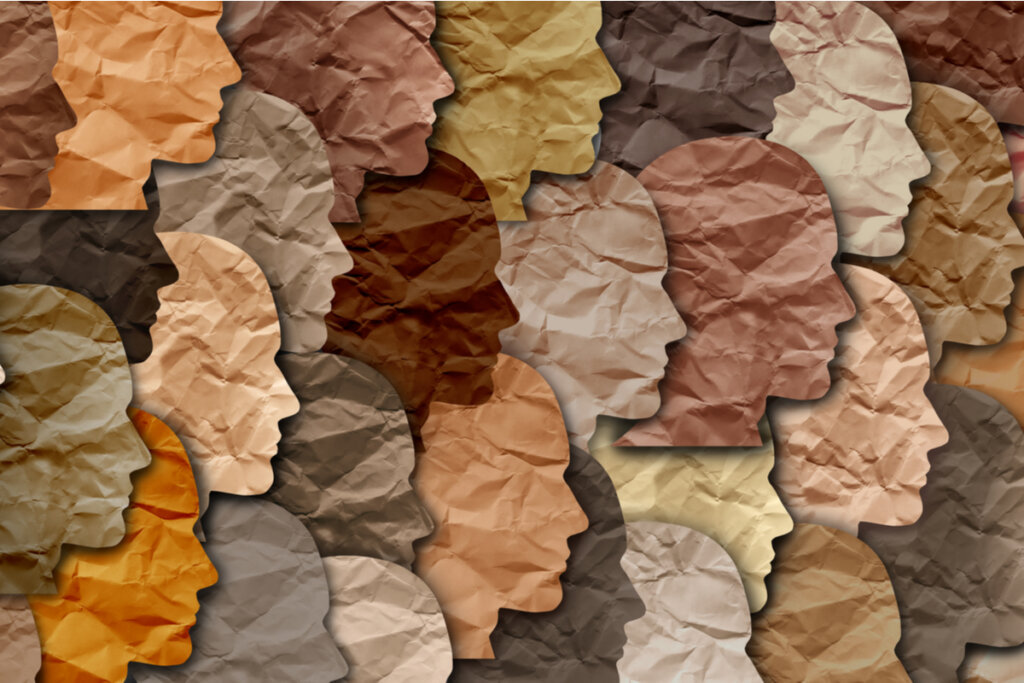The Difference Between Equity and Equality

Social justice can be understood as all those efforts aimed at fairly distributing goods, services, and resources to allow people to live dignified lives. Equity and equality are two concepts within this framework. At first glance, they might seem synonymous. However, they refer to different forms of action regarding access to social justice.
In this article, we’ll explain the difference between equity and equality. In addition, we’ll also propose some scenarios for reflection in which it’s essential to understand these concepts from an ethical perspective. This view recognizes the complexity of social inequalities and the need for everyone’s commitment to transform them.
Equality: an ideal or a possibility?
The defense of equality as a right has been one of the characteristic features of modernity. Equality was one of the principles of the French Revolution. Furthermore, it was already considered a right in the Declaration of the Rights of Man and of the Citizen of 1789. In the 20th century, its place as a fundamental right was ratified when it was included in the Universal Declaration of Human Rights of 1948.
All human beings are born equal and, consequently, all have the same rights. That’s the premise of equality as a human right.

Therefore, we can understand equality as the principle according to which all people are equal before the law. Therefore, no one condition can get in the way of the recognition of rights. Furthermore, everyone is inherently equal, regardless of their differences and particularities.
In other words, the recognition of human diversity requires the establishment of certain conditions. These conditions guarantee that all human beings receive the same treatment and value, to avoid bias and discrimination.
However, there’s undeniable inequality in the world, especially in the field of social justice. For this reason, it’s worth asking the question as to whether it’s fair to apply the principle of equality in a world that’s built on the basis of disproportionate access to goods and opportunities. Indeed, in some sectors of society, people have plenty. While at the other extreme, there are those who have nothing. Consequently, we ask the question, is equality possible in a structurally unequal world?
Equity: seeking to balance the scales
The concept of equity has been gaining strength since the 1990s. This is largely thanks to authors such as John Rawls, Amartya Sen, and Martha Nussbaum.
Equity can be understood as the search for access to social justice based on the recognition of differences and individual capacities. This recognition is aimed at guaranteeing a dignified life in a universal way. However, in some cases, this implies special considerations for social groups that are (or historically have been) in a disadvantaged condition.
In this way, equity is configured as an effort to correct historical and structural inequalities. It’s a kind of imbalance that’s built on several factors. For example, social class, educational level, ethnic origin, gender, physical and cognitive disability. Furthermore, any other conditions that imply not all people are able to access the same opportunities or have the same advantages.
For those born in marginalized environments, equity is perhaps the only possibility to change their life. A life that’s destined to reproduce these patterns of social inequality. Furthermore, equity is the only way for these people to be able to access better opportunities.
Guaranteeing historically oppressed social groups’ access to basic services, quality education, non-precarious job options, spaces free from discrimination, and other conditions to lead a dignified life is perhaps the only way to progressively make the world a fairer place.

Equality or equity? Think about the nuances
Faced with problems such as gender discrimination or racism, it’s been necessary to ask the question about the place of equality and equity in the access of women and racialized people to spaces that have historically been forbidden to them.
Affirmative actions have been framed in what’s been called ‘positive discrimination’. It seeks to make evident the importance of recognizing that, although we’re all equal, as George Orwell wrote in Animal Farm, some are more equal than others.
This means that, historically, the principle of equality meant that only those who recognized themselves as equal to each other had access to spaces of power and representation. Therefore, women, sexual dissidents, indigenous and Afro-descendant populations, people living in poverty, people with disabilities, and many others who embody otherness and difference have been left out of the distribution of the conditions that can guarantee a future and ideal equality for all human beings.
In this way, we can understand equality as a goal. Indeed, it’s an ideal that’s still, as yet, unattainable. On the other hand, equity means supporting the efforts and mechanisms toward achieving it. Indeed, supporting mechanisms such as quotaism and promoting diversity in our spaces. Furthermore, negotiating and questioning our own privileges and our own social limitations. In fact, these could well be the first steps toward the implementation of equity policies.
Social justice can be understood as all those efforts aimed at fairly distributing goods, services, and resources to allow people to live dignified lives. Equity and equality are two concepts within this framework. At first glance, they might seem synonymous. However, they refer to different forms of action regarding access to social justice.
In this article, we’ll explain the difference between equity and equality. In addition, we’ll also propose some scenarios for reflection in which it’s essential to understand these concepts from an ethical perspective. This view recognizes the complexity of social inequalities and the need for everyone’s commitment to transform them.
Equality: an ideal or a possibility?
The defense of equality as a right has been one of the characteristic features of modernity. Equality was one of the principles of the French Revolution. Furthermore, it was already considered a right in the Declaration of the Rights of Man and of the Citizen of 1789. In the 20th century, its place as a fundamental right was ratified when it was included in the Universal Declaration of Human Rights of 1948.
All human beings are born equal and, consequently, all have the same rights. That’s the premise of equality as a human right.

Therefore, we can understand equality as the principle according to which all people are equal before the law. Therefore, no one condition can get in the way of the recognition of rights. Furthermore, everyone is inherently equal, regardless of their differences and particularities.
In other words, the recognition of human diversity requires the establishment of certain conditions. These conditions guarantee that all human beings receive the same treatment and value, to avoid bias and discrimination.
However, there’s undeniable inequality in the world, especially in the field of social justice. For this reason, it’s worth asking the question as to whether it’s fair to apply the principle of equality in a world that’s built on the basis of disproportionate access to goods and opportunities. Indeed, in some sectors of society, people have plenty. While at the other extreme, there are those who have nothing. Consequently, we ask the question, is equality possible in a structurally unequal world?
Equity: seeking to balance the scales
The concept of equity has been gaining strength since the 1990s. This is largely thanks to authors such as John Rawls, Amartya Sen, and Martha Nussbaum.
Equity can be understood as the search for access to social justice based on the recognition of differences and individual capacities. This recognition is aimed at guaranteeing a dignified life in a universal way. However, in some cases, this implies special considerations for social groups that are (or historically have been) in a disadvantaged condition.
In this way, equity is configured as an effort to correct historical and structural inequalities. It’s a kind of imbalance that’s built on several factors. For example, social class, educational level, ethnic origin, gender, physical and cognitive disability. Furthermore, any other conditions that imply not all people are able to access the same opportunities or have the same advantages.
For those born in marginalized environments, equity is perhaps the only possibility to change their life. A life that’s destined to reproduce these patterns of social inequality. Furthermore, equity is the only way for these people to be able to access better opportunities.
Guaranteeing historically oppressed social groups’ access to basic services, quality education, non-precarious job options, spaces free from discrimination, and other conditions to lead a dignified life is perhaps the only way to progressively make the world a fairer place.

Equality or equity? Think about the nuances
Faced with problems such as gender discrimination or racism, it’s been necessary to ask the question about the place of equality and equity in the access of women and racialized people to spaces that have historically been forbidden to them.
Affirmative actions have been framed in what’s been called ‘positive discrimination’. It seeks to make evident the importance of recognizing that, although we’re all equal, as George Orwell wrote in Animal Farm, some are more equal than others.
This means that, historically, the principle of equality meant that only those who recognized themselves as equal to each other had access to spaces of power and representation. Therefore, women, sexual dissidents, indigenous and Afro-descendant populations, people living in poverty, people with disabilities, and many others who embody otherness and difference have been left out of the distribution of the conditions that can guarantee a future and ideal equality for all human beings.
In this way, we can understand equality as a goal. Indeed, it’s an ideal that’s still, as yet, unattainable. On the other hand, equity means supporting the efforts and mechanisms toward achieving it. Indeed, supporting mechanisms such as quotaism and promoting diversity in our spaces. Furthermore, negotiating and questioning our own privileges and our own social limitations. In fact, these could well be the first steps toward the implementation of equity policies.
All cited sources were thoroughly reviewed by our team to ensure their quality, reliability, currency, and validity. The bibliography of this article was considered reliable and of academic or scientific accuracy.
- Arenas, G. V., & Gaviria, J. A. T. (2010). La igualdad y la equidad: Dos conceptos clave en la agenda de trabajo de los profesionales de la familia. Revista Latinoamericana de Estudios de Familia, 2, 98-116.
- Fuentes Vásquez, L. Y. (2006). Género, Equidad Y Ciudadanía Análisis De Las Políticas Educativas. Nómadas, 24, 22–35.
- Urbano-Guzmán, M. C. (2014). El concepto de igualdad en algunas teorías contemporáneas de la justicia. Revista Criterio Libre Jurídico, 11(1), 123-139.
This text is provided for informational purposes only and does not replace consultation with a professional. If in doubt, consult your specialist.







